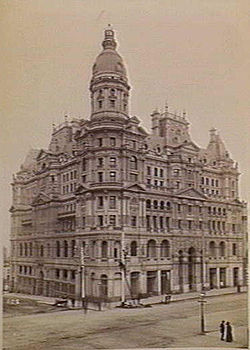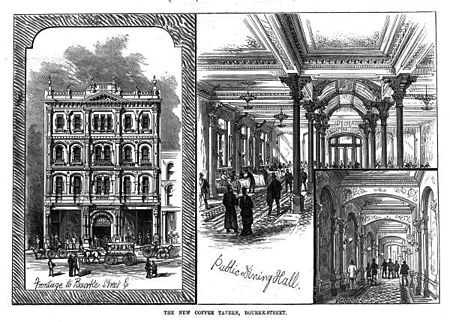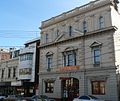- Coffee Palace
-
 The Federal Coffee Palace, erected at the height of the temperance movement was the largest and tallest building in Melbourne when it was built in 1888. The building became a hotel in the 1950s. It was proposed as a possible option for Melbourne's first casino however was instead demolished in 1972 to make way for an office development. The largest former temperance hotel in Melbourne is now the Hotel Windsor (formerly the Grand Hotel).
The Federal Coffee Palace, erected at the height of the temperance movement was the largest and tallest building in Melbourne when it was built in 1888. The building became a hotel in the 1950s. It was proposed as a possible option for Melbourne's first casino however was instead demolished in 1972 to make way for an office development. The largest former temperance hotel in Melbourne is now the Hotel Windsor (formerly the Grand Hotel).
The term Coffee Palace was primarily used in Australia to describe the temperance hotels which were built during the period of the 1880s[1] although there are references to the term also being used, to a lesser extent, in the United Kingdom. They were hotels that did not serve alcohol, built in response to the temperance movement and, in particular, the influence of the Independent Order of Rechabites in Australia. James Munro was a particularly vocal member of this movement. Coffee Palaces were often multi-purpose or mixed use buildings which included a large number of rooms for accommodation as well as ballrooms and other function and leisure facilities.
The construction of buildings for the temperance movement coincided with an economic boom in Australia and the use of richly ornamental High Victorian architecture.
Subsequently, many such hotels were given prestigious names such as "Grand" or "Royal" and were designed in the fashionable Free Classical or Second Empire styles.
The movement reached its height in Victoria and particularly Melbourne.
Catering for families, the Coffee Palaces were most popular in the coastal seaside resorts and for inner city locations popular with interstate and overseas visitors.
Ironically as the temperance movement's influence waned, many hotels applied for liquor licences. Many were either converted into hotels or demolished; however, some fine examples still survive.
Contents
Australia
Victoria
Melbourne
- Grand Coffee Palace, Melbourne (1883) (later named Windsor)
- Gladstone House Coffee Palace, North Melbourne
- The Biltmore, Albert Park (1887)
- The George, St Kilda (1887)
- Grandview Hotel, Fairfield (1888)
- Auburn Hotel, Auburn (1888)
- St Kilda Coffee Palace, St Kilda
- Mentone Coffee Palace, Mentone (1887) (Later Kilbreda Girl's School)
Regional
- Reid's Coffee Palace, Ballarat (1886)
- Mildura Coffee Palace, Mildura, Victoria
- Palace, Queenscliff (1879)
- Baillieu, Queenscliff (1881) (later renamed Ozone Hotel)
- Vue Grande, Queenscliff (1883)
- Queenscliff Hotel
Destroyed
- Federal Coffee Palace, Melbourne (demolished 1972)
- Garand Open House, Melbourne
- Victoria Coffee Palace, Melbourne
- Parer's Crystal Cafe, Melbourne
- Burke & Wills Coffee Palace, Melbourne
- Fitzroy Coffee Palace, Smith Street, Fitzroy - Constructed as a four storey building. The building has since been demolished, however two levels of the facade remain atop a Safeway supermarket.
- Queen's Coffee Palace, Carlton (demolished ~1969)
- Hawthorn Coffee Palace, Hawthorn
- Collingwood Coffee Palace, Collingwood
- Moris's (West Melbourne) Coffee Palace, West Melbourne
- Sandringham House, Sandringham
- Ozone Coffee Palace, Warrnambool
- James' Coffee Palace, Williamstown
- Sandhurst Coffee Palace, Bendigo
- Central Coffee Palace, Bendigo
Tasmania
- Imperial (Hobart) Coffee Palace, Hobart, Tasmania (built in two sections, firstly in the 1880s then extended in 1910. Cast iron verandah, balcony and mansard roof were removed during the 1950s and the 1910 extension was demolished in the 1960s)
- Tasmanian Coffee Palace, Hobart, Tasmania, 89 Macquarie St (established in Ingle Hall which was built c1814). Also known as Norman's Coffee Palace, the Orient, and Anderson's. Now home to the Mercury Print Museum.
- Federal (Sutton's) Coffee Palace (later Metropole). Brisbane Street, Launceston, Tasmania (demolished 1976)
South Australia
- Grayson's Coffee Palace, Adelaide, South Australia (demolished 1918)
- Coffee Palace, Hindley Street, Adelaide, South Australia (known as Grant's 1908-1919; Wests 1919-)
New South Wales
- Sydney Coffee Palace, Sydney, New South Wales (built 1913-1914) (demolished ?)
- Sydney Coffee Palace, Woolloomooloo, New South Wales
- Grand Central Coffee Palace (1880), Sydney
- North Queensland Coffee Palace, George Street, Sydney
- Canberra Coffee Palace, Manly, New South Wales (built 1912, demolished 1955)
- Dorrigo Coffee Palace, [Hickory St, Dorrigo, New South Wales] (burnt down sometime after 1923)
Queensland
- People's Palace, Brisbane (built 1910-11, still standing 2010)[2]
- Royal George, Nambour, Queensland (built 1911, licenced in 1912 and destroyed by fire on 15 February 1961)
Western Australia
- 1904 Wise Directory has 20 coffee palaces listed in Perth and other locations in W.A> [3][4]
United Kingdom
- Douglas Coffee Palace, Douglas, Isle of Man (demolished 1930)[5]
- Newport Street Coffee Palace, Swindon
- Ossington Coffee Palace, Newark-on-Trent
See also
Bibliography
- Grand Hotels: Reality and Illusion. Elaine Denby. Reaktion Books, 2002
References
- ^ Grand Hotels: Reality and Illusion. Elaine Denby. Reaktion Books, 2002. pg 174
- ^ "Entry CHIMS14871". Queensland Heritage Register. Queensland Environmental Protection Agency. http://www.epa.qld.gov.au/chims/placeDetail.html?siteId=14871.
- ^ http://www.slwa.wa.gov.au/find/guides/wa_history/post_office_directories/1904 pp.730-731 on 0396.pdf
- ^ Brady, Wendy (1983) Serfs of the sodden scone: women workers in the West Australian hotel and catering industry, 1900-1925 - in Studies in Western Australian History number 7 (Women in Western Australian history), pp.33-45 - including work in coffee palaces
- ^ http://www.douglas.gov.im/GalleryShowCat.asp?Cat=Streets&ID=46
External links
- Trove search for Coffee palaces - http://trove.nla.gov.au/result?q=coffee+palaces+australia
Categories:- Buildings and structures in Melbourne
- Hotels in Australia
Wikimedia Foundation. 2010.




















